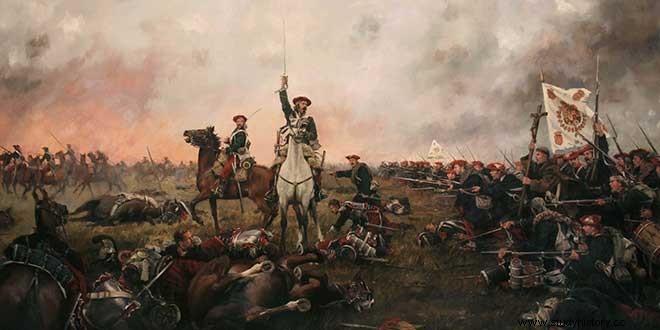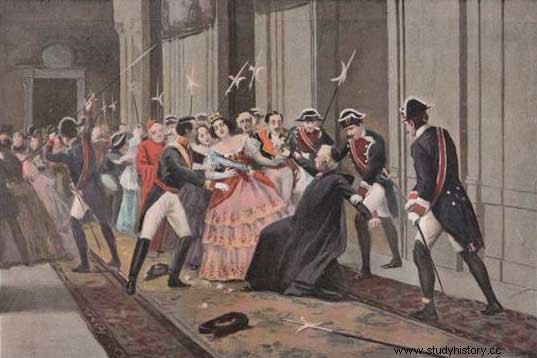Isabel II was queen of Spain. She was born on October 10, 1830 in Madrid. She is the daughter of Fernando VII and is his fourth wife, María Cristina. . He had not yet turned three years old when his father died, who, by will, left his wife María Cristina, the guardianship of his daughters, the regency and the Government of the monarchy until his daughter Isabel turned eighteen old; she also appointed a council of government, to advise her. On October 3, 1833, the Carlist War began, which lasted seven years . England, France and Portugal immediately recognized Queen Elizabeth II; but not so Pope Gregory XVI (1831-1846) nor the northern countries. A decree, dated November 30, 1833, ended the territorial division that had existed in Spain since 1802, and divided the Spanish territory into 49 provinces, among which the Canary Islands were a single province.
The quadruple alliance treaty
On April 17, 1834, the queen regent convened the General Courts of the kingdom, which were to be made up of two estates:that of the heroes and that of the attorneys. On April 22 of the same year, Spain signed the Treaty of the Quadruple Alliance with France, England and Portugal, to expel, from the latter country, the followers of Don Miguel (who aspired to the Portuguese throne) and those of Don Carlos (the Carlists), who, upon hearing of this Alliance, went to England .
Abolitionoftheinquisitioncourt
In July of the same year, 1834, cholera appeared in Madrid, and the rumor spread that the friars had poisoned the fountains; a crowd launched itself against the convents of Madrid and killed many religious. On July 15, 1834, María Cristina, by decree, definitively abolished the Court of the Inquisition, which no longer existed in any other country .
Movements of the Carlists
In the same month, from England, Don Carlos arrived in Navarra, embraced Zumalacárregui, who was the Carlist general commander there, and gave him the rank of field marshal. Later, because of his many victories over the liberal armies, he was promoted to lieutenant general. On October 25, 1834, when the Cortes of the kingdom met, the two estates, by vote, approved the exclusion of Don Carlos and his descendants from all rights to the Crown of Spain , although, in the future, it may correspond to them due to the death of all the other heirs of the same. On the 30th of the same month, Don Carlos established his Court in Oñate. A Decree-Law dated November 6, 1834 totally and definitively abolished all benefits related to the Vote of Santiago and “the protective courts of said vote” . On July 24, 1835, Zumalacárregui died as a result of having been wounded in the leg by a rifle shot at the siege of Bilbao .
Enactment of a new constitution
By Royal Decree of February 19, 1836, Minister Juan Álvarez Mendizábal began the sale of the expropriated property to the religious Orders (what is known as the confiscation of Mendizábal); the sale of these goods in public auction lasted until April 9, 1854; The State obtained, with these sales, some three thousand five hundred million (3,500,000,000) reais approximately.
On August 12, 1836, there was a riot in La Granja, where the regent was spending the summer, and the leaders of the revolt appeared before her and forced her to sign a decree, which restored the Constitution of 1812, the revolt spread and there were several murders, including those of Captain Quesada and the governor of Malaga. On June 18, 1837, a new Constitution was promulgated .

End of the carlist war
The Carlist war continued; but there came a time when Maroto, general in chief of the Carlist armies, began negotiations with General Espartero, which ended in the Vergara agreement , signed on August 31, 1839, by which the Carlist War ended; Don Carlos was taken to France by Espartero, who later went to Morella (Castellón), where the most important Carlist army remained under the command of General Cabrera, who fled to Catalonia with 12,000 men; but, after being twice defeated by General O'Donnell he fled to France on July 7, 1840; then the Carlist resistance ended. However, the situation was becoming more and more difficult, uprisings, riots and the fall of governments occurred with great frequency, which is why María Cristina resigned the regency in favor of Espartero on October 12, 1840, and, On the 17th of the same month, he went to Rome, then went to Naples and, finally, settled in Paris .
Reign of Elizabeth II
Agustín Argüelles was appointed tutor to Queen Elizabeth II; but, given the course of events, Isabel was declared of legal age on November 8, 1843 by the Cortes , before which Queen Elizabeth II was sworn in two days later. By decrees of March 28 and April 12 of the same year the Civil Guard was created. On May 18, 1845, Don Carlos abdicated his claims to the throne of Spain in his son, the Count of Montemolín (Charles VI of the Carlists), and he abdicated in his brother John in 1861 . On the 23rd of the same month, the reform of the Constitution of 1837 was approved.
On October 10, 1846, Queen Elizabeth II married her first cousin Francisco de Asís, son of the Infante Francisco de Paula (brother of Fernando VII).
Creation of the peseta and attack on Queen Elizabeth II
In 1848, the peseta appeared in the Spanish monetary system; but not as a monetary unit, but only as a multiple of the real, which still continued to be the monetary unit. On February 2, 1852, the priest Merino carried out an attack against Queen Elizabeth II, and he was executed two days later. In the summer of 1859 in Extremadura, the republicans produced a revolt; his boss, Sixto Cámara, fled; but many of them were arrested and shot.

War with morocco
The Moroccans destroyed some fortifications in Ceuta; so the Government of Spain declared war on Morocco on October 22, 1859; was carried out by Prim and O`Donnell, and ended with the Peace Treaty of Tetouan at the request of Morocco on April 26, 1860; By virtue of this treaty, Spain increased its field in Ceuta, another treaty of 1854 referring to Melilla was ratified and an indemnity equivalent to four hundred million reais in Moorish copper eighths was given to the Spanish Government. , which were the origin of what came to be called small change .
Ostend and Brussels Pact
Military uprisings followed with increasing frequency, with their consequent executions, as well as the fall of countless governments; the social conflict, the economic crisis and unemployment were very great; there was no clear solution to so many serious problems. Exiled progressives and democrats signed the Pact of Ostend (Belgium) on August 16, 1866, by which they created a revolutionary platform led by General Prim, to overthrow Isabel II and that a Constituent Cortes elected by universal suffrage decided the form of Government that should be adopted in Spain. The clauses of that Pact were ratified, on June 30, 1867, in the Brussels Pact. In July 1868, a Secret Committee was created in Madrid made up of unionists and progressives, which served as contact between General Prim, who was in London, and the generals that the Government of Isabel II had exiled to the Canary Islands in the same month of July:Serrano, Dulce, Zabala, Córdoba, Echagüe, Caballero de Rodas, etc. At the same time, several clandestine organizations were operating in Madrid, which conspired against Queen Elizabeth II, such as the Center of the Progressive Conspirators, the Club of the Friends of the People, etc.
Isabel II is dethroned
By September 1868, the pronouncement was already prepared; Prim traveled from London to Gibraltar, then went to Cádiz, where the generals who were exiled in the Canary Islands also arrived; then, on September 18, 1868, in Cadiz, the Spanish squadron began the pronouncement to the cry of Long live Spain with honor! This rebellion quickly spread to other provinces:Malaga, Seville, Almeria, etc.; the revolution (called “the Glorious” ) had succeeded. Queen Elizabeth II was dethroned and expelled from Spain on the 27th of that same month, and, on the 30th, she crossed the border to Paris, where she established her residence and spent the rest of her life she . From her marriage to Francisco de Asís, she had several daughters and her son Alfonso, from whom she abdicated on June 25, 1870. Elizabeth II died on April 9, 1904. During her reign, the School of Forest Engineers was founded, the Royal Theater was built and the Canal that bears the name of Isabel II was started.
